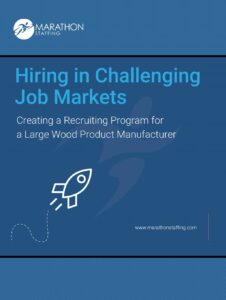As the national labor shortage continues to put pressure on employers to meet production demands, many organizations are considering wage increases as one way to achieve required staffing levels. As strategic advisors to more than 2,000 production-focused businesses, the first question many executives ask us is, “If we increase our pay rate to X, do you think we’ll get higher-quality employees?
In most scenarios, unfortunately, the answer is no. Although marginally increasing pay rates won’t enhance the effectiveness of your workforce, it will increase the number of applicants who come to you looking for work.
So, why doesn’t more automatically equal better?
The labor market abides by the same rules of supply and demand as every other financial market. As price/pay rates move upward, the supply of available job seekers increases. Alas, quantity doesn’t equal quality. So yes, in theory, with more available talent and the deployment of effective HR practices, employers should, on average, be able to enhance the productivity of their workforce. But in practice, for many already short-staffed companies, increasing the supply of applicants will only get them to where they want to be: fully staffed.
The good news is that, unlike buying a carton of milk, wage is one of many things people consider when deciding where to work. Because of the multifactored nature of the decision, a strategic employer can differentiate their workplace from competing employers. So, the need to have a compelling story that goes beyond wage matters when hiring conditional workers (temps, contractors, and per diem workers) to support production, because temporary positions are viewed as inherently riskier than direct employer positions.
With the above in mind, here are three strategies you can execute now to attract more temporary workers without increasing your cost of labor:
Communicate your company’s value proposition to job seekers: People are driven by purpose. What is your company’s ‘why’ and how are you communicating it to the outside world? Chipotle and Taco Bell serve similar products, often pay similar rates, and employ individuals with similar skillsets, so why do people flock to work at Chipotle while Taco Bell goes quietly unnoticed? Don’t get me wrong, I love Taco Bell, but Chipotle’s mission—to provide food with integrity—permeates every business activity, offering a direct, invigorating acknowledgment of the contributions of its front-line staff.
Workforce development and training: Employees’ expectations of their employers have been evolving for the past ten years. For many people, work must surpass simply collecting a paycheck. Employees want to work for an employer who invests in them.
For strategic employers, there are plenty of low-cost levers you can pull to meet this need and set your organization apart. For example, our company, Marathon, builds a custom 30-day onboarding program as an integral part of our large workforce development solution. Our implementation is specific to the demands of each employer partner, but it often includes creating signals to identify new employers, align mentors, celebrate milestones and enhance the program based on feedback. And this kind of program offers a double benefit, helping retain talent while attracting new talent with a powerful story.
Create an inclusive culture for temporary workers that celebrates their successes: What do temps, contractors, employees, and per diem workers all have in common? They’re human beings. Organizations that segregate ‘temps’ from their direct employee base create cultural signals, structures and norms that work against their business goals. Even though temporary workers aren’t legally employed by your organization, they’re critical to ensuring that your organization achieves its mission. So, it’s crucial, whenever possible, to celebrate contingent workers’ contributions.
For example, for many of our employer partners, Marathon’s team members are invited to participate in company outings, sports teams, and important safety meetings. And Marathon frequently builds success profiles for team members who started off with us and then transitioned to having successful careers with our employer partners.
Activities and acknowledgements like these usually cost very little, but they play huge dividends in an organization’s ability to differentiate its contingent opportunities from its competitors’.
Written by:
Christopher Panagiotopoulos
Team Member Innovation
chris@marathonstaffing.com



